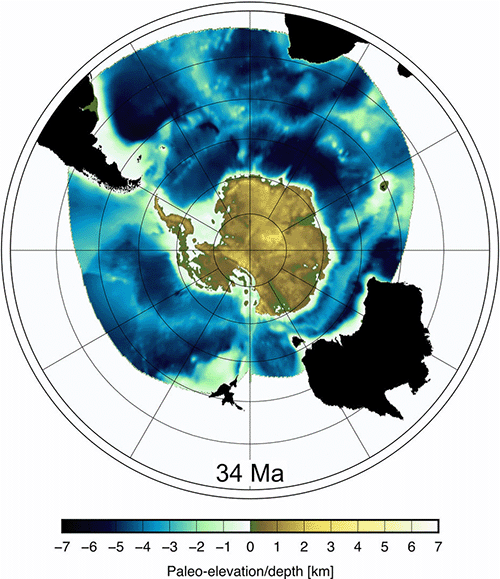 High-resolution simulations of ocean circulations 34 million years ago show that the tectonic opening of Southern Ocean seaways caused a fundamental reorganisation of ocean currents, heat transport and initiated a strong Antarctic surface water cooling of 5 °C. The new study conducted by an international team of SCAR researchers from the Netherlands, Australia, UK, Germany, and Norway, will be published in the November 9th issue of Nature Communications. The results shed new light on a 50-year-old question about how and why the Antarctic ice sheets formed.
High-resolution simulations of ocean circulations 34 million years ago show that the tectonic opening of Southern Ocean seaways caused a fundamental reorganisation of ocean currents, heat transport and initiated a strong Antarctic surface water cooling of 5 °C. The new study conducted by an international team of SCAR researchers from the Netherlands, Australia, UK, Germany, and Norway, will be published in the November 9th issue of Nature Communications. The results shed new light on a 50-year-old question about how and why the Antarctic ice sheets formed.
The last land bridges connecting Antarctica with its surrounding continents, Australia, and South America, broke off about 34 million years ago. This tectonic event did not only leave the polar continent isolated by other land masses; it also led to a major reorganisation of ocean currents in the Southern Ocean. A circumpolar current started to flow preventing subpolar gyres from transporting warm surface waters to the Antarctic coast. At the same time, ice sheets started to build on Antarctica and the Earth underwent one of its most fundamental climate change events, transitioning from warm Greenhouse to cold Icehouse conditions. The role of the opening seaways in the formation of Antarctic ice sheets, versus decreasing amounts of greenhouse gases in the atmosphere, has always been strongly debated. New research led by Dr Isabel Sauermilch, researcher at University of Tasmania and Utrecht University, shows that these events were much more closely linked than previously thought. The authors’ high-resolution ocean simulations show that only a small deepening of the Southern Ocean seaways by a few hundred metres led to a dramatic cooling of the Antarctic surface waters. Together with declining atmospheric carbon dioxide (CO2) concentrations, this tectonic event played a crucial role in the first glaciation of Antarctica and in the Earth’s transition into an Icehouse world.
Plate tectonics as a key climate driver
The results presented in this study demonstrate the importance of tectonically driven processes in the changing oceanographic and climatic conditions of the Southern Ocean. These outcomes need to be carefully assessed, especially in conjunction with changing atmospheric CO2 changes as the other key climate driver. Understanding these ancient climate stages is crucial in order to validate climate models that predict future climate conditions and to understand how the climate might behave under higher atmospheric carbon dioxide (CO2) concentrations.
Reference
Article in Nature Communications: “Gateway-driven weakening of ocean gyres leads to Southern Ocean cooling”, by Isabel Sauermilch, Joanne Whittaker, Andreas Klocker, Dave Munday, Katharina Hochmuth, Peter Bijl, and Joe LaCasce, 9th November 2021. DOI: 10.1038/s41467-021-26658-1
This article contributes to the SCAR PAIS and INSTANT programmes and has been conducted by an international team of SCAR researchers from the Netherlands, Australia, UK, Germany, and Norway.

This illustration shows the evolution of the Southern Ocean during the past 34 million years (sources: Hochmuth et al 2020; Paxman et al 2019)
Top image: surface temperatures around Antarctica before (left) and after (right) the opening of the Southern Ocean seaways. The high resolution ocena simulations show that simply deepening of the two gateways to >600m depths cause a temperature drop of up to 5 degrees C.
